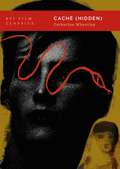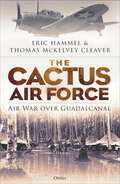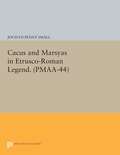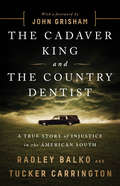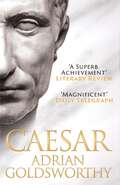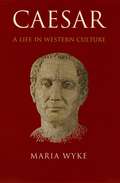- Table View
- List View
Cabinets for the Curious: Looking Back at Early English Museums (Perspectives on Collecting)
by Ken ArnoldThe last few years has, within museums, witnessed nothing short of a revolution. Worried that the very institution was itself in danger of becoming a dusty, forgotten, culturally irrelevant exhibit, vigorous efforts have been made to reshape the museum mission. Fearing that history was coming to be ignored by modern society, many institutions have instead marketed a de-intellectualised heritage, overly relying on computer technology to captivate a contemporary audience. The theme of this work is that we can do much to reassess the rationale that inspires contemporary collections through a study of seventeenth century museums. England's first museums were quite literally wonderful; founded that is on the disciplined application of the faculty of wonder. The type of wonder employed was not that post-Romantic idea of disbelief, but rather an active form of curiosity developed during the Renaissance, particularly by the individuals who set about gathering objects and founding museums to further their enquiries. The argument put forward in this book is that this museological practice of using objects actually to create, as well as disseminate knowledge makes just as much sense today as it did in the seventeenth century and, further, that the best way of reinvigorating contemporary museums, is to return to that form of wonder. By taking such a comparative approach, this book works both as a scholarly historical text, and as an historically informed analysis of the key issues facing today's museums. As such, it will prove essential reading both for historians of collecting and museums, and for anyone interested in the philosophies of modern museum management.
Cabinets in Eastern Europe
by J. Blondel F. Müller-RommelCabinets in Eastern Europe is a comprehensive study which enables the reader to compare the origins, structure, composition and activities of these cabinets and to draw lessons from this comparison. Each chapter begins with a survey of the evolution of cabinets since the fall of communism at the beginning of the 1990s. The emphasis is then laid on the place of the cabinet in the constitution and on the role of presidents and prime ministers in the formation of the life of each cabinet. At a time when most Eastern European countries are candidates for membership in the European Union, this volume provides a unique comparative presentation of the way in which cabinets have been evolving in Eastern Europe since the end of communism.
The Cabot Voyages and Bristol Discovery under Henry VII (Hakluyt Society, Second Series)
by R.A. SkeltonThe voyages of John and Sebastian Cabot and their English contemporaries were made, for the most part, in search of a westward passage to Asia, and they resulted in the revelation of North America. The evidences are printed here, with an indication of their origins. Some are obscure in meaning, incomplete in statement, or mutually contradictory; and we are left with the certainty that important documents have existed or may now exist, which are still unknown. Dr Williamson interprets the evidence we have. Parts of his undertaking are in the nature of detective work and he does not claim that his solutions are final, which would be impossible in the face of new evidence that may at any time occur. Cabot study is a continuing mental adventure. The maps are an important category of the evidence. Mr R.A. Skelton of the British Museum has contributed a treatment of them, authoritative in its explanations, and a valuable admonition on what can and cannot be expected of the material. This is a new print-on-demand hardback edition of the volume first published in 1962.
The Cabot Voyages and Bristol Discovery under Henry VII (Hakluyt Society, Second Series)
by R.A. SkeltonThe voyages of John and Sebastian Cabot and their English contemporaries were made, for the most part, in search of a westward passage to Asia, and they resulted in the revelation of North America. The evidences are printed here, with an indication of their origins. Some are obscure in meaning, incomplete in statement, or mutually contradictory; and we are left with the certainty that important documents have existed or may now exist, which are still unknown. Dr Williamson interprets the evidence we have. Parts of his undertaking are in the nature of detective work and he does not claim that his solutions are final, which would be impossible in the face of new evidence that may at any time occur. Cabot study is a continuing mental adventure. The maps are an important category of the evidence. Mr R.A. Skelton of the British Museum has contributed a treatment of them, authoritative in its explanations, and a valuable admonition on what can and cannot be expected of the material. This is a new print-on-demand hardback edition of the volume first published in 1962.
Caché (BFI Film Classics)
by Catherine WheatleyEver since its world premiere at the Cannes film festival in May 2005, audiences have been talking about Michael Haneke's Caché. The film's enigmatic and multi-layered narrative leaves its viewers with many more questions than answers. The plot revolves around the mystery of who is sending a series of sinister videos and drawings to Georges Laurent (Daniel Auteuil), the presenter of a literary talkshow. As Georges becomes increasingly secretive, much to the distress of his wife Anne (Juliette Binoche), a culprit fails to surface. And even at the film's end, audiences are left struggling to make sense of what has gone before.This hasn't stopped people trying. In an in-depth and illuminating account, Wheatley examines the key themes at the heart of the 'meaning' of Caché: the film as thriller; post-colonial bourgeois guilt; political accountability and lastly, reality, the media and its audiences, tracing these strands through the film by means of close readings of individual scenes and moments. Inspired by the director's claim that we might understand the film as a set of Russian dolls, each of which is complete in itself but together forms a whole in which layers of unseen depth are concealed, Wheatley avoids a single, unifying approach to understanding Caché. Instead, her detailed analysis of the film's shifting perspectives opens up the multiplicity of meanings that Caché contains, in order to understand its secrets.This edition includes a new foreword in which the author reflects upon Caché in the context of Haneke's subsequent work, and considers the film's contemporary resonances in an era of omnipresent surveillance technology and doctored 'fake news' videos.
Caché (BFI Film Classics)
by Catherine WheatleyEver since its world premiere at the Cannes film festival in May 2005, audiences have been talking about Michael Haneke's Caché. The film's enigmatic and multi-layered narrative leaves its viewers with many more questions than answers. The plot revolves around the mystery of who is sending a series of sinister videos and drawings to Georges Laurent (Daniel Auteuil), the presenter of a literary talkshow. As Georges becomes increasingly secretive, much to the distress of his wife Anne (Juliette Binoche), a culprit fails to surface. And even at the film's end, audiences are left struggling to make sense of what has gone before.This hasn't stopped people trying. In an in-depth and illuminating account, Wheatley examines the key themes at the heart of the 'meaning' of Caché: the film as thriller; post-colonial bourgeois guilt; political accountability and lastly, reality, the media and its audiences, tracing these strands through the film by means of close readings of individual scenes and moments. Inspired by the director's claim that we might understand the film as a set of Russian dolls, each of which is complete in itself but together forms a whole in which layers of unseen depth are concealed, Wheatley avoids a single, unifying approach to understanding Caché. Instead, her detailed analysis of the film's shifting perspectives opens up the multiplicity of meanings that Caché contains, in order to understand its secrets.This edition includes a new foreword in which the author reflects upon Caché in the context of Haneke's subsequent work, and considers the film's contemporary resonances in an era of omnipresent surveillance technology and doctored 'fake news' videos.
The Cactus Air Force: Air War over Guadalcanal
by Eric Hammel Thomas McKelvey CleaverUsing diary entries, interviews and first-hand accounts, this vivid narrative brings to life the struggle in the air over the island of Guadalcanal between August 20 and November 15, 1942. For 40 years from 1961, the late Eric Hammel interviewed more than 150 American participants in the air campaign at Guadalcanal, none of whom are still alive. These interviews are the most comprehensive first-person accounts of the battle assembled by any historian. More importantly, they involved the junior officers and enlisted men whose stories and memories were not part of the official history, thus providing a unique insight. The battle of Guadalcanal was the first offensive operation undertaken by the US and its allies in the Pacific War. "Cactus," the code name for the island, became a sinkhole for Japanese air and naval power, experienced forces whose losses could never be made good. The three months of air battles between August 20, 1942, when the first Marine air unit arrived on the island, and November 15, when the last enemy attempt to retake the island was defeated, were perhaps the most important of the Pacific War. After November 15, 1942, the US never looked back as its forces moved across the Pacific to the war's inevitable conclusion. The Cactus Air Force is a joint project between the late Eric Hammel and Pacific War expert Thomas McKelvey Cleaver, and is unlike any other of the many histories of this event that have been published over the years.
The Cactus Air Force: Air War over Guadalcanal
by Eric Hammel Thomas McKelvey CleaverUsing diary entries, interviews and first-hand accounts, this vivid narrative brings to life the struggle in the air over the island of Guadalcanal between August 20 and November 15, 1942. For 40 years from 1961, the late Eric Hammel interviewed more than 150 American participants in the air campaign at Guadalcanal, none of whom are still alive. These interviews are the most comprehensive first-person accounts of the battle assembled by any historian. More importantly, they involved the junior officers and enlisted men whose stories and memories were not part of the official history, thus providing a unique insight. The battle of Guadalcanal was the first offensive operation undertaken by the US and its allies in the Pacific War. "Cactus," the code name for the island, became a sinkhole for Japanese air and naval power, experienced forces whose losses could never be made good. The three months of air battles between August 20, 1942, when the first Marine air unit arrived on the island, and November 15, when the last enemy attempt to retake the island was defeated, were perhaps the most important of the Pacific War. After November 15, 1942, the US never looked back as its forces moved across the Pacific to the war's inevitable conclusion. The Cactus Air Force is a joint project between the late Eric Hammel and Pacific War expert Thomas McKelvey Cleaver, and is unlike any other of the many histories of this event that have been published over the years.
Cacus and Marsyas in Etrusco-Roman Legend. (PMAA-44), Volume 44 (PDF)
by Jocelyn Penny SmallThis book discusses how Greek and South Italian vase paintings of the musical contest between Apollo and Marsyas became the model for Etruscan representations of Cacus ambushed by the Vibennae brothers, two Etruscan heroes of the sixth century B.C. The study demonstrates that the Etruscans knowingly adapted Greek iconographic forms to represent their own legends.Originally published in 1982.The Princeton Legacy Library uses the latest print-on-demand technology to again make available previously out-of-print books from the distinguished backlist of Princeton University Press. These editions preserve the original texts of these important books while presenting them in durable paperback and hardcover editions. The goal of the Princeton Legacy Library is to vastly increase access to the rich scholarly heritage found in the thousands of books published by Princeton University Press since its founding in 1905.
The Cadaver King and the Country Dentist: A True Story of Injustice in the American South
by Radley Balko Tucker CarringtonA shocking and deeply reported account of the persistent plague of institutional racism and junk forensic science in our criminal justice system, and its devastating effect on innocent livesAfter two three-year-old girls were raped and murdered in rural Mississippi, law enforcement pursued and convicted two innocent men: Kennedy Brewer and Levon Brooks. Together they spent a combined thirty years in prison before finally being exonerated in 2008. Meanwhile, the real killer remained free.The Cadaver King and the Country Dentist recounts the story of how the criminal justice system allowed this to happen, and of how two men, Dr. Steven Hayne and Dr. Michael West, built successful careers on the back of that structure. For nearly two decades, Hayne, a medical examiner, performed the vast majority of Mississippi's autopsies, while his friend Dr. West, a local dentist, pitched himself as a forensic jack-of-all-trades. Together they became the go-to experts for prosecutors and helped put countless Mississippians in prison. But then some of those convictions began to fall apart.Here, Radley Balko and Tucker Carrington tell the haunting story of how the courts and Mississippi's death investigation system--a relic of the Jim Crow era--failed to deliver justice for its citizens. The authors argue that bad forensics, structural racism, and institutional failures are at fault, raising sobering questions about our ability and willingness to address these crucial issues.
Cade's Justice (Mills And Boon Vintage 90s Modern Ser.)
by Pat TracyGideon Cade Was Consumed By One Desire, until the night the angelic Emma Step, all fire and fury, demanded entry to his home and transformed his life.
The Cædmon Poems (Routledge Library Editions: The Anglo-Saxon World #6)
by Charles W. KennedyThe Caedmon Poems (1916) contains the texts of Caedmon’s poems, the birth of Christian poetry in England. The poems are reproduced in a modern English translation, with an extensive introduction to each.
The Cædmon Poems (Routledge Library Editions: The Anglo-Saxon World #6)
The Caedmon Poems (1916) contains the texts of Caedmon’s poems, the birth of Christian poetry in England. The poems are reproduced in a modern English translation, with an extensive introduction to each.
Caen 1944: Montgomery’s break-out attempt (Campaign)
by Peter Dennis Ken FordOne of the key objectives of British forces on D-Day was the capture of the strategically vital city of Caen. General Montgomery saw Caen as the key to Normandy and the springboard for the Allied breakout, but so did the Germans and the city did not fall. It took three major offensives and more than 30 bloody days of struggle to finally take Caen. In the process the city was controversially devastated and its civilian population decimated. The Allies paid a high price for Caen but the horrific German casualties bled their forces in Normandy white and helped open the way for the American breakout in Operation Cobra.
Caen 1944: Montgomery’s break-out attempt (Campaign #143)
by Peter Dennis Ken FordOne of the key objectives of British forces on D-Day was the capture of the strategically vital city of Caen. General Montgomery saw Caen as the key to Normandy and the springboard for the Allied breakout, but so did the Germans and the city did not fall. It took three major offensives and more than 30 bloody days of struggle to finally take Caen. In the process the city was controversially devastated and its civilian population decimated. The Allies paid a high price for Caen but the horrific German casualties bled their forces in Normandy white and helped open the way for the American breakout in Operation Cobra.
Caesar: The Life Of A Colossus (Essential Histories Specials Ser. #42)
by Adrian GoldsworthyFrom the very beginning, Caesar's story makes dazzling reading. In his late teens he narrowly avoided execution for opposing the military dictator Sulla. He was decorated for valour in battle, captured and held to ransom by pirates, and almost bankrupted himself by staging games for the masses. As a politician, he quickly gained a reputation as a dangerously ambitious maverick. By his early 30s he had risen to the position of Consul, and was already beginning to dominate the Senate. His affairs with noblewomen were both frequent and scandalous.His greatest skill, outside the bedroom, was as a military commander. In a string of spectacular victories he conquered all of Gaul, invaded Germany, and twice landed in Britain - an achievement which in 55BC was greeted with a public euphoria comparable to that generated by the moon landing in 1969. In just thirty years he had risen from a position of virtual obscurity to become one of the richest men in the world, with the power single-handedly to overthrow the Republic. By his death he was effectively emperor of most of the known world.
Caesar (Masters of Rome #5)
by Colleen McCulloughRome 54 BC: Caesar's legions are sweeping across Gaul, brutally subduing the tribes who defy him. But, in Rome, his enemies are plotting his downfall and disgrace. Vindictive schemers like Cato and Bibulus, the spineless Cicero, the avaricious Brutus. Even Pompey, Caesar's former ally. But all have underestimated Caesar. When the Senate refuse to give him his due he marches upon Rome, an army prepared to die for him at his back. Rome is his destiny – a destiny that will impel him to the banks of the Rubicon, and beyond, into legend. Please note: This ebook contains all the original maps and illustration.
Caesar: A Life in Western Culture
by Maria WykeMore than two millennia have passed since Brutus and his companions murdered Julius Caesar—and inaugurated his legend. Though the assassins succeeded in ending Caesar’s dictatorship, they could never have imagined that his power and influence would only grow after his death, reaching mythic proportions and establishing him as one of the central icons of Western culture, fascinating armchair historians and specialists alike. With Caesar, Maria Wyke takes up the question of just why Julius Caesar has become such an exalted figure when most of his fellow Romans have long been forgotten. Focusing on key events in Caesar’s life, she begins with accounts from ancient sources, then traces the ways in which his legend has been adapted and employed by everyone from Machiavelli to Madison Avenue, Shakespeare to George Bernard Shaw. Napoleon and Mussolini, for example, cited Caesar’s crossing of the Rubicon in defense of their own dictatorial aims, while John Wilkes Booth fancied himself a new Brutus, ridding America of an imperial scourge. Caesar’s personal life, too, has long been fair game—but the lessons we draw from it have changed: Suetonius derided Caesar for his lustfulness and his love of luxury, but these days he and his lover Cleopatra serve as the very embodiment of glamour, enticingly invoked everywhere from Caesars Palace in Las Vegas to the hit HBO series Rome. Caesar is the witty and perceptive work of a writer who is as comfortable with the implications of Xena: Warrior Princess as with the long shadow cast by the Annals of Tacitus. Wyke gives us a Caesar for our own time: complicated, hotly contested, and perpetually, fascinatingly renewed.
Caesarea Philippi: Banias, the Lost City of Pan
by John Francis WilsonSometime in 1997 the ancient city of Banias passed its 2000th anniversary, yet there was no celebration. John Francis Wilson brings us the story of Banias, or ancient Caesarea Philippi, the city that sat at the source of the Jordan River in what are now known as the Golan Heights region. In doing so he brings to life a city whose history is a microcosm of that of the Middle East itself. Banias' story starts in Canaanite times. Under Herod Phillip( died AD 34)it became Caesarea Philippi and was a focal point for the cult of the god Pan throughout the Roman period. With the accession of the Christian Emperor Constantine its pagan heritage brought it into conflict with emerging Christianity. In the following centuries came Arab conquest, the Crusades, neglect and decay, rediscovery in the 19th century by European travellers and finally its destruction in the Six Days War after being occupied by Israeli forces. Wilson reminds us that cities without people are desolate: interspersed amongst the invasions and religious conflicts are the people whose lives touched the life of this city: Herod the Great and his sons, Jesus of Nazareth, the emperors Vespasian and Titus, Saladin and even Samuel Clemens, otherwise known as Mark Twain. John Francis Wilson has had complete access to the site, and has drawn upon a wealth of sources in order to provide the first comprehensive history of this remarkable city . Its story will make fascinating reading to historians, general readers and those interested in the archaeology and narrative of the Near East."A welcome and refreshing departure from the usual type of publication about an ancient city. " "It is the first comprehensive treatment of the history of a major ancient settlement at the interface of several important cultural, political and religious forces throughout its long history. As such, it has an especially colourful and interesting story, now enhanced by recent archaeological excavation on the site. The author has done full justice to this and presented an engrossing and well written narrative" - James Russell, Professor Emeritus, University of British Columbia
Caesar's Civil War (Oxford Approaches to Classical Literature)
by William W. Batstone Cynthia DamonCaesar's Civil War, the story of the general's contest with the Pompeian party through nineteen months of civil war, is an unfinished masterpiece. The author abandoned it when he found himself living in a different world than that which saw its commencement. The narrative ends after Pompey's death, amidst the preliminaries to the Alexandrian war that initiated the next phase of the fight for primacy of Rome. The work shows the brilliance for which Caesar's oratory, like his generalship, was known: it was a political judgment, not a literary one, that relegated the Civil War to the file drawer. The primary topics covered in this introductory book are the generic background of Caesar's commentarii or notebooks; his selection of material; the contemporary context of the civil war; the literary techniques that carry the story; and the work's characterization and structure. General aids to the reader include maps to accompany the particular narrative events discussed, a timeline of Caesar's life and the civil war, explanations of technical terms of Roman history, and a section on Roman names and prominent persons of Caesar's time.
Caesar's Civil War: 49–44 BC (Guide to... #42)
by Adrian GoldsworthyJulius Caesar and Pompey the Great were two of the greatest generals Rome had ever produced. Together they had brought vast stretches of territory under Roman dominion. In 49 BC they turned against each other and plunged Rome into civil war. Legion was pitched against legion in a vicious battle for political domination of the vast Roman world. Based on original sources, Adrian Goldsworthy provides a gripping account of this desperate power struggle. The armies were evenly matched but in the end Caesar's genius as a commander and his great good luck brought him victory in 45 BC.
Caesar's Civil War: 49–44 BC (Essential Histories)
by Adrian GoldsworthyFully illustrated with colour maps and images, this is an accessible introduction to Julius Caesar's Civil War.Julius Caesar and Pompey the Great were two of the greatest generals Rome had ever produced. Together they had brought vast stretches of territory under Roman dominion. In 49 BC they turned against each other and plunged Rome into civil war. In this book, Adrian Goldsworthy relates the gripping story of this desperate power struggle. Drawing on original accounts of the war, he examines how legion was pitched against legion in a vicious battle for political domination of the vast Roman world. The armies were evenly matched, but in the end, Caesar's genius as a commander and his great good luck brought him victory in 45 BC. Updated and revised for the new edition, with full-colour maps and 40 new images, this is a detailed introduction to one of the last conflicts in the Roman Republic before the establishment of the Roman Empire.
Caesar's Civil War: 49–44 BC (Essential Histories #42)
by Adrian GoldsworthyFully illustrated with colour maps and images, this is an accessible introduction to Julius Caesar's Civil War.Julius Caesar and Pompey the Great were two of the greatest generals Rome had ever produced. Together they had brought vast stretches of territory under Roman dominion. In 49 BC they turned against each other and plunged Rome into civil war. In this book, Adrian Goldsworthy relates the gripping story of this desperate power struggle. Drawing on original accounts of the war, he examines how legion was pitched against legion in a vicious battle for political domination of the vast Roman world. The armies were evenly matched, but in the end, Caesar's genius as a commander and his great good luck brought him victory in 45 BC. Updated and revised for the new edition, with full-colour maps and 40 new images, this is a detailed introduction to one of the last conflicts in the Roman Republic before the establishment of the Roman Empire.
Caesar's Civil War 49-44 BC: 49-44 Bc (Essential Histories)
by Adrian GoldsworthyFirst published in 2004. Routledge is an imprint of Taylor & Francis, an informa company.




